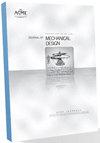Dynamic Trajectory Planning for a Three Degrees-of-Freedom Cable-Driven Parallel Robot Using Quintic B-Splines
IF 2.9
3区 工程技术
Q2 ENGINEERING, MECHANICAL
引用次数: 23
Abstract
This paper presents a new trajectory planning method based on the improved quintic B-splines curves for a three degrees-of-freedom (3-DOF) cable-driven parallel robot (CDPR). First, the conditions of positive cables’ tension are expressed in terms of the position and acceleration constraints of the end-effector. Then, an improved B-spline curve is introduced, which is employed for generating a pick-and-place path by interpolating a set of given via-points. Meanwhile, by expressing the position and acceleration of the end-effector in terms of the first and second derivatives of the improved B-spline, the cable tension constraints are described in the form of B-spline parameters. According to the properties of the defined pick-and-place path, the proposed motion profile is dominated by two factors: the time taken for the end-effector to pass through all the via-points and the ratio between the nodes of B-spline. The two factors are determined through multi-objective optimization based on the efficiency coefficient method. Finally, experimental results on a 3-DOF CDPR show that the improved B-spline exhibits overall superior behavior in terms of velocity, acceleration, and cables force compared with the traditional B-spline. The validity of the proposed trajectory planning method is proved through the experiments.基于五次b样条的三自由度缆索驱动并联机器人动态轨迹规划
提出了一种基于改进五次b样条曲线的三自由度索驱动并联机器人轨迹规划方法。首先,用末端执行器的位置和加速度约束来表示缆索正张力的条件。然后,引入了一种改进的b样条曲线,该曲线通过插值一组给定的过点来生成拾取路径。同时,通过用改进b样条的一阶导数和二阶导数表示末端执行器的位置和加速度,以b样条参数的形式描述索张力约束。根据所定义的拾取路径的性质,所提出的运动轮廓由两个因素决定:末端执行器通过所有过点所花费的时间和b样条节点之间的比率。通过基于效率系数法的多目标优化确定这两个因素。最后,在3-DOF CDPR上的实验结果表明,与传统的b样条相比,改进的b样条在速度、加速度和索力方面表现出更好的整体性能。通过实验验证了所提轨迹规划方法的有效性。
本文章由计算机程序翻译,如有差异,请以英文原文为准。
求助全文
约1分钟内获得全文
求助全文
来源期刊

Journal of Mechanical Design
工程技术-工程:机械
CiteScore
8.00
自引率
18.20%
发文量
139
审稿时长
3.9 months
期刊介绍:
The Journal of Mechanical Design (JMD) serves the broad design community as the venue for scholarly, archival research in all aspects of the design activity with emphasis on design synthesis. JMD has traditionally served the ASME Design Engineering Division and its technical committees, but it welcomes contributions from all areas of design with emphasis on synthesis. JMD communicates original contributions, primarily in the form of research articles of considerable depth, but also technical briefs, design innovation papers, book reviews, and editorials.
Scope: The Journal of Mechanical Design (JMD) serves the broad design community as the venue for scholarly, archival research in all aspects of the design activity with emphasis on design synthesis. JMD has traditionally served the ASME Design Engineering Division and its technical committees, but it welcomes contributions from all areas of design with emphasis on synthesis. JMD communicates original contributions, primarily in the form of research articles of considerable depth, but also technical briefs, design innovation papers, book reviews, and editorials.
 求助内容:
求助内容: 应助结果提醒方式:
应助结果提醒方式:


